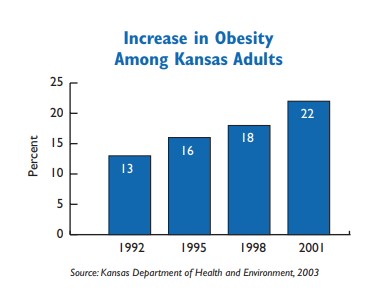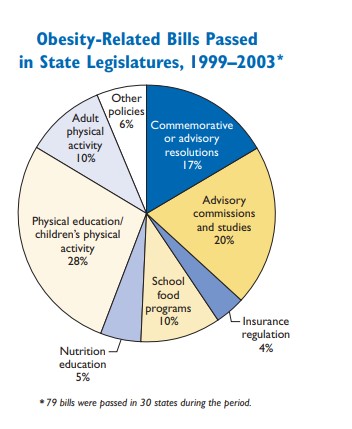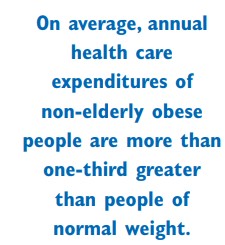Some argue that public health problems, by definition, are public policy problems because they affect the welfare of the entire population. Others claim that the aggregate of individual behavior that does not affect the health of others is not sufficient to raise a public health problem to the level of a public policy problem.
On the other hand, certain health issues such as sexually transmitted diseases and diseases caused or exacerbated by secondhand smoke may become public policy issues if policymakers perceive that the prevalence of the behaviors is a danger to the public. Because obesity is not a communicable disease and its direct impact on the health of others is limited, many policymakers claim that the “obesity epidemic” requires no public policy intervention.
Personal behavior rises to the level of public policy, some claim, when it negatively affects a group or class of individuals. Such may be the case in regard to obesity. Consider the social consequences of obesity in the following circumstances:
Obesity-related social costs
On average, annual health care expenditures of non-elderly obese people are more than one-third greater than people of normal weight. In Kansas, the cost of obesity-attributable medical expenditures totals $657 million per year, at least $143 million of which is paid by the Medicaid program. If current trends continue, one dollar out of every five spent on health care in the year 2020 will be spent on obesity-related conditions.
While many economic and non-economic costs of obesity are born by overweight individuals, some of the economic costs of obesity related to health care are shifted to others. Just as healthier people subsidize the care of those who are less healthy and who consume more health care services, people who are not obese pay higher health insurance premiums to subsidize care provided to obese members in their health plan and those without health insurance. Medicaid expenditures, financed by tax revenues, are greater than they would be if the obesity rate of beneficiaries was lower. Obesity lowers profitability of businesses and may lower productivity, employee pay raises and benefit expansions.
Bias and discrimination
Clear evidence exists of pervasive bias against overweight people across key sectors including employment, education, health care and housing. The power of negative attitudes (bias), in some cases, may produce unreasonable actions (discrimination) against overweight people.
No federal laws exist currently to protect obese individuals from discrimination. Michigan is alone among states in prohibiting employment discrimination on the basis of weight. A handful of cities have adopted ordinances that include weight in their definitions of unlawful discrimination.
Overweight and obesity are associated with lower incomes and lower levels of educational attainment, but association is not the same as causation. How much of the association results from overweight people being unfairly denied opportunities at school, at work and in the medical system? To what extent is overweight a cause of lower income and lower education? Certainly, other explanations exist for the relationship between obesity and income and education, but we may be mistaken to think that the explanations flow in one direction only.
Racial and ethnic disparities
African Americans and people of Hispanic origin living in the U.S. have a higher prevalence of overweight and obesity than White Americans. One possible explanation is that low-income minorities are subject to environments in which low-cost, energy-dense foods composed of refined grains, added sugars and certain fats are more readily available than more nutritious foods. Unequal access to health education and treatment services may exacerbate obesity and its accompanying health conditions in some minority groups.
Certainly, not all members of a particular minority group are overweight. Because obesity has a tendency to aggregate in families, however, there may be a genetic component to obesity susceptibility. Recent research concludes that genetics play a “large part” in susceptibility to obesity. This stream of research suggests that a number of genes, each with a small effect, contribute to an individual’s susceptibility to obesity. Obesity, like many other health conditions, is caused by the interaction of genetics and environmental conditions.
Some argue that indigenous people in premodern societies developed a biological adaptation that allowed them to cope with alternating periods of feast and famine. The so-called “thrifty genome model” allowed them to store fat when food was plentiful as a hedge against starvation in times of famine. The genes, which were once important to survival, now no longer serve a function. In fact, they have become harmful, because fat, originally stored for famine situations, is not used up. Additionally, many have traded a more active lifestyle for one that is more sedentary.
Ultimately body weight is determined by individual behavior, but the same behaviors can affect individuals differently. Many minorities may be disadvantaged by their genetic predisposition, poverty and the environments in which they live.
The role of public schools
One approach for reversing the epidemic of obesity is to concentrate on obesity prevention in children. Learning healthy behaviors at a young age will accrue benefits throughout the life-course of an individual.
As quasi-governmental organizations, public schools have a duty to protect the health and safety of the children in their charge. As learning institutions, schools should attempt to remove barriers to performance within their control that allow children to optimize their potential. Offering instruction in good health habits (balanced nutrition and physical fitness) and reinforcing the lesson by providing an environment that supports healthy eating and physical activity fulfills both duties.



